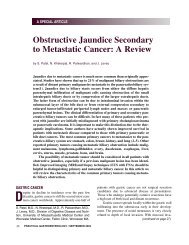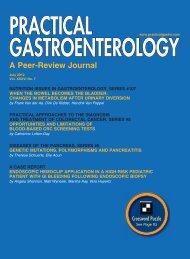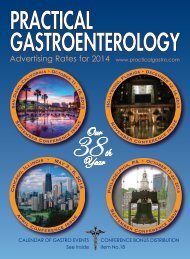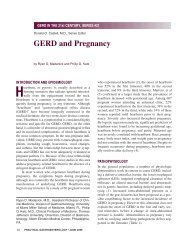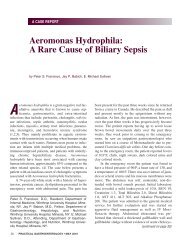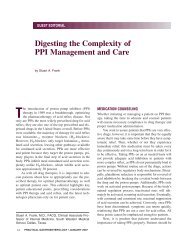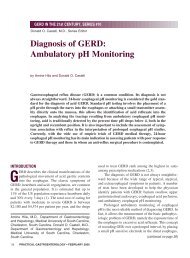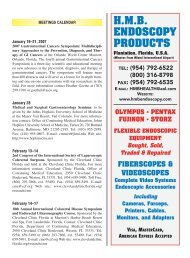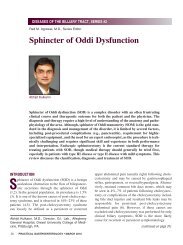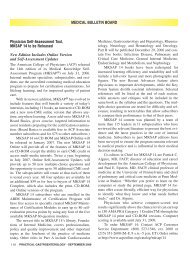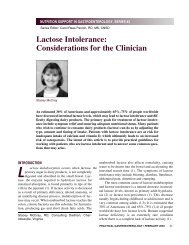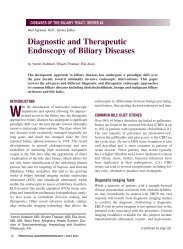Milk Thistle for Alcoholic or Hepatitis B or C Liver Disease Treatment ...
Milk Thistle for Alcoholic or Hepatitis B or C Liver Disease Treatment ...
Milk Thistle for Alcoholic or Hepatitis B or C Liver Disease Treatment ...
You also want an ePaper? Increase the reach of your titles
YUMPU automatically turns print PDFs into web optimized ePapers that Google loves.
FROM THE LITERATURE<br />
<strong>Milk</strong> <strong>Thistle</strong> <strong>f<strong>or</strong></strong> <strong>Alcoholic</strong> <strong>or</strong><br />
<strong>Hepatitis</strong> B <strong>or</strong> C <strong>Liver</strong> <strong>Disease</strong><br />
Randomized clinical trial studies in patients with alcoholic<br />
and/<strong>or</strong> hepatitis B and C liver disease were<br />
included in the assessment. Randomized clinical trials<br />
were evaluated by components of methodologic quality.<br />
Thirteen randomized clinical trials assessed milk<br />
thistle (MT) in 915 patients with alcoholic and/<strong>or</strong><br />
hepatitis B <strong>or</strong> C liver diseases. The methodologic quality<br />
was low; only 23 percent of the trials rep<strong>or</strong>ted adequate<br />
allocation concealment and only 46 percent were<br />
considered double-blind. MT versus placebo <strong>or</strong> no<br />
intervention <strong>f<strong>or</strong></strong> a median duration of 6 months had no<br />
significant effect on all cause-m<strong>or</strong>tality complications<br />
of liver disease <strong>or</strong> liver histology. <strong>Liver</strong>-related m<strong>or</strong>tality<br />
was significantly reduced by MT in all trials, but<br />
not in high-quality trials. MT was not associated, with<br />
a significantly increased risk of adverse events.<br />
Based on high-quality trials, MT does not seem to<br />
significantly influence the course of patients with alcoholic<br />
and/<strong>or</strong> hepatitis B <strong>or</strong> C liver disease. MT could<br />
potentially effect liver injury. Adequately controlled<br />
clinical trials with MT versus placebo may be needed.<br />
(Rambaldi A, Jacobs B, Iaquinto G, et al. “<strong>Milk</strong> <strong>Thistle</strong><br />
<strong>f<strong>or</strong></strong> <strong>Alcoholic</strong> and/<strong>or</strong> <strong>Hepatitis</strong> D <strong>or</strong> C <strong>Liver</strong> <strong>Disease</strong>—<br />
A Systematic Cochrane Hepato-Biliary Group Review<br />
with Meta-Analyses of Randomized Clinical Trials.”<br />
Amer J Gastroenterol, 2005; Vol. 100, 2583-2591.)<br />
<strong>Treatment</strong> of <strong>Hepatitis</strong> C in Children<br />
The evaluation of the efficacy, safety and pharmacokinetics<br />
of Interferon Alfa-2a and Ribavirin in children<br />
with chronic hepatitis C was carried out. The optimal<br />
Ribavirin dose was used after identified, in combination<br />
with Interferon and Alfa-2B, finally in a phase 3<br />
trial. The primary efficacy end-point in all studies was<br />
sustained virological response, defined by undetectable<br />
serum HCV RNA 24 weeks after completion<br />
of therapy. All efficacy and safety analyses were per<strong>f<strong>or</strong></strong>med<br />
on the intent-to-treat population. Children<br />
receiving Interferon Alfa-2B plus Ribavirin 15 mg/kg<br />
in the phase one study had the maximum reduction in<br />
serum HCV RNA at treatment, weeks 4 and 12, with<br />
an acceptable safety profile.<br />
In all, 46 percent (54/118) of optimally treated<br />
children achieved sustained virological response. That<br />
response was significantly higher in genotype 2/3 (84<br />
percent), than in those with genotype 1 (36%).<br />
Adverse events led to dose modification in 31 percent<br />
and discontinuation in 7 percent. Multiple-dose Interferon<br />
Alfa-2B and Ribavirin peak and trough concentration<br />
and area-under-the-curve were similar between<br />
children and adults.<br />
In conclusion, Interferon Alfa-2B in combination<br />
with Ribavirin is effective and safe in children with<br />
chronic hepatitis C viral infection. (Gonzalez-Peralta<br />
RT, Kelly DA, Haber B, et al, <strong>f<strong>or</strong></strong> the International<br />
Pediatric <strong>Hepatitis</strong> C Therapy Group. Hepatology,<br />
2005; Vol. 42, 1010-1018.)<br />
Entecavir and Lamivudine-Refract<strong>or</strong>y HBV<br />
A randomized dose-ranging, phase 2 study compared<br />
the efficacy and safety of Entecavir with Lamivudine<br />
in Lamivudine-refract<strong>or</strong>y patients. <strong>Hepatitis</strong> Be antigen<br />
positive and negative patients (182), viremic displayed<br />
Lamivudine treatment <strong>f<strong>or</strong></strong> 24 <strong>or</strong> m<strong>or</strong>e weeks, <strong>or</strong><br />
having documented Lamivudine resistant substitutions,<br />
were switched directly to Entecavir (1, 0.5 <strong>or</strong> 0.1<br />
mg daily), <strong>or</strong> continued on Lamivudine 400 mg daily<br />
<strong>f<strong>or</strong></strong> up to 76 weeks.<br />
At week 24, significantly m<strong>or</strong>e patients receiving<br />
Entecavir 1 mg (79%), <strong>or</strong> 0.5 mg (51%), had undetectable<br />
HBV DNA levels by branched chain assay,<br />
compared with Lamivudine (13%).<br />
Entecavir 1mg was superi<strong>or</strong> to 0.5 mg <strong>f<strong>or</strong></strong> the standard<br />
point. After 48 weeks, a mean reduction in HBV<br />
DNA levels was 5.86, 4.46 and 2.85 log 10 copies/mL.<br />
Entecavir 1 mg, 0.5 mg and 0.1 mg, respectively was<br />
significantly higher than 1.37 log 10 copies/mL on<br />
Lamivudine. Significantly higher prop<strong>or</strong>tion of<br />
patients achieved n<strong>or</strong>malization of ALT on Entecavir<br />
(continued on page 88)<br />
V I S I T O U R W E B S I T E A T<br />
P R A C T I C A L G A S T R O . C O M<br />
86<br />
PRACTICAL GASTROENTEROLOGY • MARCH 2006
FROM THE LITERATURE<br />
(continued from page 86)<br />
than on Lamivudine. One virologic resistance occurred<br />
in the 0.5 mg group.<br />
It was concluded that in HbeAg-positive and<br />
HBeAg-negative Lamivudine refract<strong>or</strong>y patients<br />
treated with Entecavir 1mg and 0.5 mg daily was well<br />
tolerated and resulted in significant reduction in HBV<br />
DNA levels and n<strong>or</strong>malization of ALT. 1mg of Entecavir<br />
was considered m<strong>or</strong>e effective than 0.5 mg in this<br />
population. (Chang TT, Ishi RG, Hadzaynnis J, et al.<br />
<strong>f<strong>or</strong></strong> the BEHoLZ Study Group. Gastroenterology,<br />
2005; Vol. 129, pp. 1198-1209.)<br />
Steatosis and Hemochromatosis<br />
Two hundred fourteen patients with hemochromatosis<br />
who were homozygous with C282Y substitution HFe,<br />
and who had undergone liver biopsy pri<strong>or</strong> to phlebotomy<br />
were studied. Steatosis was present in 41.1<br />
percent of patients. Fourteen percent had moderate <strong>or</strong><br />
severe steatosis. Median serum ALT and ferritin levels<br />
were higher and median transferrin saturation, and<br />
hepatic iron concentration were lower in subjects with<br />
steatosis, compared with subjects without steatosis.<br />
Bivariate analysis revealed a significant association<br />
with steatosis and fibrosis. Following multiple logistic<br />
regression, steatosis was independently associated<br />
with fibrosis, along with male sex, excess alcohol consumption<br />
and hepatic iron content. Note: higher BMT<br />
and alcohol consumption was associated with the presence<br />
of steatosis.<br />
It was concluded that these findings indicate that<br />
obesity-related steatosis may have a role as a cofact<strong>or</strong><br />
in liver injury in hemochromatosis. There is an imp<strong>or</strong>tant<br />
clinical implication that suggests that obesity<br />
should be actively addressed <strong>f<strong>or</strong></strong> management of<br />
patients with hemochromatosis, as well as other liver<br />
diseases. (Powell A, Clauston AG, et al. “Steatosis in<br />
a Co-Fact<strong>or</strong> in <strong>Liver</strong> Injury Hemochromatosis.” Gastroenterology,<br />
2005; Vol. 129, 1937-1943.)<br />
Clostridium Difficile and Acid Suppression<br />
A two population-based, case-controlled study using<br />
the United Kingdom General Practice Research Database<br />
was conducted. Sixteen hundred seventy-two<br />
cases of C. difficile rep<strong>or</strong>ted between 1994 and 2004<br />
were identified among all patients registered <strong>f<strong>or</strong></strong> at<br />
least 2 years in each practice. Each case was matched<br />
to ten controls on calendar time and the general practice.<br />
In the second study, a subset of these cases<br />
defined as community-acquired (i.e., not hospitalized<br />
in the pri<strong>or</strong> year), were matched on practice and age<br />
with controls also not hospitalized in the pri<strong>or</strong> year.<br />
The outcome measured the incidence of C. difficile<br />
and risk associated with gastric acid- suppressive agent<br />
use. The incidence of C. difficile in patients diagnosed<br />
by their general practitioners increased from less than<br />
one case per 100,000 in 1994 to 22 per 100,000 in<br />
2004. The adjusted rate ratio of C. difficile-associated<br />
disease with current use of proton pump inhibit<strong>or</strong>s was<br />
2.9 and with H 2 -recept<strong>or</strong> antagonists, the rate ratio was<br />
2.0. An elevated rate was also found with the use of<br />
NSAIDs at 1.3.<br />
It was concluded that use of acid-suppressive therapy,<br />
particularly proton pump inhibit<strong>or</strong>s, is associated<br />
with an increased risk of community-acquired C. difficile.<br />
The unexpected increase in risk with NSAIDs<br />
will require further investigation. (Dial S, Delaney<br />
JAC, Barkan-Suiss AS.” Use of Gastric Acid-Suppressive<br />
Agents and the Risk of Community-acquired<br />
Clostridium Difficile-Associated <strong>Disease</strong>.” JAMA,<br />
2005; Vol. 294: 2989-2995.)<br />
Four Day Bravo pH Capsule Monit<strong>or</strong>ing<br />
Eighteen patients underwent four-day ambulat<strong>or</strong>y pH<br />
testing, using two separate receivers calibrated to a single<br />
Bravo pH capsule. Rabeprazole was administered<br />
on days 2 to 4 of the study (20 mg <strong>or</strong>ally b.i.d.). Indications<br />
<strong>f<strong>or</strong></strong> pH testing were refract<strong>or</strong>y heartburn, chest<br />
pain <strong>or</strong> chronic cough. A pH rec<strong>or</strong>ding showed that 9<br />
patients (53 percent), had esophageal acid exposure<br />
values that exceeded 4 percent on day 1 and 7 patients<br />
(41 percent) had values that exceeded 5.3 percent.<br />
Patients showed significant and progressive reductions<br />
in acid exposure on days 2 to 4 of the rep<strong>or</strong>ted<br />
period. Of the 7 patients with quantitatively abn<strong>or</strong>mal<br />
levels of acid exposure on day 1, 86 percent had n<strong>or</strong>malization<br />
by day 3.<br />
(continued on page 90)<br />
88<br />
PRACTICAL GASTROENTEROLOGY • MARCH 2006
FROM THE LITERATURE<br />
(continued from page 88)<br />
It was concluded that prolonged esophageal pH<br />
rec<strong>or</strong>dings using the Bravo system are feasible and<br />
allow <strong>f<strong>or</strong></strong> combined testing, both off and on a therapeutic<br />
trial of PPI. Such studies may allow <strong>f<strong>or</strong></strong> the<br />
acquisition of complementary in<strong>f<strong>or</strong></strong>mation in a single<br />
test and may be useful in the management of patients<br />
with suspected gastroesophageal reflux disease symptoms.<br />
(Hirano I, Vang Q, Pandolfino JE, Kahrilas PK.<br />
“Four Day Bravo pH Capsule Monit<strong>or</strong>ing, With and<br />
Without Proton Pump Inhibit<strong>or</strong> Therapy.” Clin Gastroenterol<br />
Hepatol, 2005; Vol. 3,1083-1088.)<br />
Ascites, Impaired Gastric Function<br />
and Nutritional Intake<br />
Patients with cirrhosis and ascites underwent assessment<br />
of gastric volumes as measured by single-photon computed<br />
tomography, gastric sensation assessed by a validated<br />
nutrient drink test and a 3-day assessment of<br />
cal<strong>or</strong>ic intake be<strong>f<strong>or</strong></strong>e and after large volume paracentesis.<br />
Paired Wilcoxon rank-sum tests were used to compare<br />
gastric measure be<strong>f<strong>or</strong></strong>e and after paracentesis<br />
among the patient group. Fifteen patients were compared<br />
with 112 healthy controls. Median postprandial<br />
gastric volumes and gastric accommodation were<br />
reduced significantly in patients compared with healthy<br />
controls. After paracentesis, fasting gastric volumes<br />
were increased. Patients tolerated ingestion of large and<br />
maximum volumes and cal<strong>or</strong>ic intake was increased.<br />
It was concluded that postprandial gastric volumes<br />
and accommodation ratios are reduced in patients with<br />
cirrhosis and ascites, compared with healthy controls.<br />
Large volume paracentesis increase fasting gastric volume;<br />
volumes suggested a total maximum satiation<br />
and cal<strong>or</strong>ic intake. (Aqel BA, Scolapio JS, Dickson<br />
RC, Burton DT, Bouras EP. “Contribution of Ascites to<br />
Impaired Gastric Functional. and Nutritional Intake in<br />
Patients With Cirrhosis and Ascites.” Clin Gastroenterol<br />
Hepatol, 2005; Vol. 3, 1095-1100.)<br />
<strong>Treatment</strong> of Intrahepatic<br />
Cholestasis of Pregnancy<br />
Intrahepatic cholestasis of pregnancy is characterized<br />
by troublesome maternal pruritus, elevated serum bile<br />
acids and increased fetal risk. It has been determined<br />
that a cutoff level of serum bile acids equal to <strong>or</strong><br />
greater than 40umol/L can be associated with impaired<br />
fetal outcome. This study was carried out to evaluate<br />
the effects of ursodeoxycholic acid (UDCA) and Dexamethasone<br />
on pruritus, biochemical markers of<br />
cholestasis and fetal complication rates in a doubleblind,<br />
placebo-controlled trial. One hundred thirty<br />
women with ICP were randomly allocated to UDCA<br />
(one gram per day <strong>f<strong>or</strong></strong> 3 weeks), <strong>or</strong> Dexamethasone (12<br />
mg per day <strong>f<strong>or</strong></strong> one week and placebo during weeks 2<br />
and 3), <strong>or</strong> placebo <strong>f<strong>or</strong></strong> 3 weeks.<br />
Pruritus and biochemical markers of cholestasis<br />
were analyzed at inclusion and after 3 weeks of treatment.<br />
Fetal complications were registered at delivery.<br />
An intention to treat analysis showed significant reduction<br />
of ALT and bilirubin in the UDCA group only. In a<br />
subgroup analysis of ICP women with serum bile acids<br />
equal to <strong>or</strong> greater than 40 umol/L at inclusion, UDCA<br />
had significant effects on pruritus, bile acids, ALT and<br />
bilirubin, as well, but not on fetal complication rates.<br />
Dexamethasone yielded no alleviation of pruritus<br />
<strong>or</strong> reduction of ALT and was less effective than UDCA<br />
at reducing bile acids and bilirubin.<br />
It was concluded that three weeks of UDCA treatment<br />
improves biochemical markers of ICP, irrespective<br />
of disease severity, whereas significant relief from<br />
pruritus and marked reduction of serum bile acids were<br />
only found in patients with severe ICP. (Glantz A,<br />
Marschall H, Lammert F, Matteson L. “Intrahepatic<br />
Cholestasis of Pregnancy: A Randomized Controlled<br />
Trial Comparing Dexamethasone and Ursodeoxycholic<br />
Acid.” Hepatology, 2005; Vol. 42, 1399-1405.)<br />
Incidence of Barrett’s Esophagus<br />
A random sample, including 3,000 adults as a representative<br />
of the adult population (21,610) was carried<br />
out in two units. The use of Palatine was surveyed<br />
using the validated gastrointestinal symptom questionnaire.<br />
A random subset sample of 1,000 patients<br />
underwent upper endoscopy. Endoscopic signs suggested<br />
a columnar-lined esophagus (CLE) and were<br />
defined as mucosal tongues <strong>or</strong> an upward shift of the<br />
squamocolumnar junction. Barrettes esophagus (BE)<br />
was diagnosed when specialized intestinal metaplasia<br />
was detected histologically in suspected CLE.<br />
(continued on page 92)<br />
90<br />
PRACTICAL GASTROENTEROLOGY • MARCH 2006
FROM THE LITERATURE<br />
(continued from page 90)<br />
BE was present in sixteen subjects (1.6 percent),<br />
five with a long segment and 11 with a sh<strong>or</strong>t segment.<br />
Overall, 40 percent: rep<strong>or</strong>ted reflux symptoms and 15.<br />
5 percent showed esophagitis; 103 (10 percent) had<br />
suspected CLE and 12 (1.2 percent) had a visible segment<br />
greater <strong>or</strong> equal to 2 cm.<br />
The prevalence of BE in those with reflux symptoms<br />
was 2.3 percent and in those without reflux<br />
symptoms was 1.2 percent. In those with esophagitis,<br />
the prevalence was 2. 6 percent. In those without the<br />
prevalence, it was 1.4 percent. Alcohol and smoking<br />
were independent risk fact<strong>or</strong>s <strong>f<strong>or</strong></strong> BE.<br />
It was concluded that BE was found in 1.6 percent<br />
of the general Swedish population. In this study, alcohol<br />
and smoking were significant risk fact<strong>or</strong>s. Ed<br />
Note: (Sixteen patients only). (Ronkainen J, Aro P,<br />
St<strong>or</strong>z-Krubb T, et al. “Prevalence of Barrett’s Esophagus<br />
in the General Population: An Endoscopic Study.”<br />
Gastroenterology, 2005; Vol. 129, 1825-1831.)<br />
NSAID-Induced Small Bowel Pathology<br />
F<strong>or</strong>ty healthy volunteers underwent a baseline capsule<br />
enteroscopy and fecal calprotectin test after taking<br />
Diclofenac Slow-Release 75 mg capsules b.i.d. with<br />
omeprazole 20 mg b.i.d. <strong>f<strong>or</strong></strong> gastroprotection, <strong>f<strong>or</strong></strong> a total<br />
of 14 days. Both investigations were repeated. After<br />
drug treatment, 30 subjects had increased repeat fecal<br />
calprotectin concentrations above the upper limits of<br />
n<strong>or</strong>mal. Capsule enteroscopy showed new pathology in<br />
27 subjects (68%). The most common lesions were<br />
mucosal breaks, seen in 16% <strong>or</strong> 40%, which were seen<br />
to be bleeding in two (5%); reddened folds in 14 (35%).<br />
Petechiae <strong>or</strong> red spots were seen in 13 (33%). Denuded<br />
mucosa was seen in 8 (20%), with blood in the lumen,<br />
without a visualized source 3 (8%). Fifteen of the 27<br />
subjects had m<strong>or</strong>e than one lesion concurrently.<br />
It was concluded that this study provides both biochemical<br />
and direct evidence of macroscopic injury to the<br />
small intestine, 68% to 75 % of volunteers resulting from<br />
2 weeks ingestion of Slow-Release Diclofenac. (Maiden<br />
L, Thjodleifsson S, Theod<strong>or</strong> A, Gonzales J, Bjarnason I.<br />
“A Quantitative Analysis of NSAID-Induced Small<br />
Bowel Pathology by Capsule Enteroscopy.” Gastroenterology,<br />
2005; Vol. 128, 1172-1178.)<br />
Infliximab Therapy <strong>f<strong>or</strong></strong> Fistulizing Crohn’s <strong>Disease</strong><br />
After 5 mg/kg infliximab at weeks 0, 2 and 6, a total of<br />
282 patients were separately randomized at week 14 as<br />
responders, including a 50% reduction from baseline<br />
in the number of draining fistulas at both weeks 10 and<br />
14, <strong>or</strong> nonresponders to receive placebo with 5 mg/kg<br />
infliximab maintenance every 8 weeks. At week 22<br />
and later, patients who lost response could be treated<br />
with a maintenance dose 5 mg/kg higher. Data on<br />
Crohn’s disease-related hospitalizations, surgeries and<br />
procedures were compared between the three groups<br />
<strong>f<strong>or</strong></strong> responders in all randomized patients.<br />
A total of 282 patients were randomized at week 14,<br />
of whom 195 were randomized as responders. Among<br />
patients randomized as responders, those who received<br />
Visit<br />
Practical<br />
Gastroenterology<br />
during the show<br />
at Booth #600.<br />
92<br />
PRACTICAL GASTROENTEROLOGY • MARCH 2006
FROM THE LITERATURE<br />
infliximab maintenance had significantly fewer days<br />
(0.5 versus 2.5) of hospitalization. All surgeries and procedures<br />
as well as maj<strong>or</strong> surgeries were compared with<br />
those who received placebo maintenance.<br />
It was concluded that in patients with fistulizing<br />
Crohn’s disease, infliximab 5 mg/kg every 8 weeks<br />
significantly reduced hospitalizations, surgeries and<br />
procedures, compared with placebo. (Lichtenstein GR,<br />
Yan S, Bala M, Blank M, Sanders BE. “Infliximab<br />
Maintenance <strong>Treatment</strong> Reduces Hospitalizations,<br />
Surgeries and Procedures in Fistulizing Crohn’s <strong>Disease</strong>.”<br />
Gastroenterology, 2005; Vol. 128, 862-869.)<br />
Banding and Propanolol Prophylaxis<br />
<strong>f<strong>or</strong></strong> Initial Variceal Hem<strong>or</strong>rhage<br />
To compare endoscopic banding with propanolol <strong>f<strong>or</strong></strong> prevention<br />
of first variceal hem<strong>or</strong>rhage, a multicenter<br />
prospective trial was carried out. Sixty-two patients with<br />
cirrhosis with high-risk esophageal varices were randomized<br />
to propanolol, titrated to reduce resting pulse by 25<br />
% <strong>or</strong> m<strong>or</strong>e, <strong>or</strong> banding per<strong>f<strong>or</strong></strong>med monthly until varices<br />
were eradicated. This was followed up with the same<br />
schedule <strong>f<strong>or</strong></strong> a duration of 15 months. Primary end point<br />
of treatment failure was defined as a result of endoscopically-documented<br />
variceal hem<strong>or</strong>rhage <strong>or</strong> a severe medical<br />
complication requiring discontinuance therapy. The<br />
trial was stopped early after an interim analysis showed<br />
that the failure rate of propanolol was significantly higher<br />
than that of banding. Significantly m<strong>or</strong>e propanolol than<br />
banding patients had esophageal variceal bleeding (4/31<br />
vs. 0/31). The difference was 12.9 %.<br />
The cumulative m<strong>or</strong>tality rate was significantly<br />
higher in the propanolol than the banding group.<br />
Direct costs of care were not significantly different.<br />
It was concluded that <strong>f<strong>or</strong></strong> patients with cirrhosis<br />
with high risk esophageal varices and no hist<strong>or</strong>y of<br />
variceal hem<strong>or</strong>rhage, propanolol-treated patients had<br />
significantly higher failure rates, first esophageal,<br />
varix hem<strong>or</strong>rhage and cumulative m<strong>or</strong>tality than banding<br />
patients. (Jutaba JR, Jensen DM, Martin T, et al.<br />
“Randomized Study comparing Banding and<br />
Propanolol to Prevent Initial Variceal Hem<strong>or</strong>rhage in<br />
Cirrhotics with High Risk Esophageal Varices.” Gastroenterology,<br />
2005; Vol. 128, 870-881.)<br />
Murray H. Cohen, D.O., edit<strong>or</strong> of “From the Literature” is a<br />
member of the Edit<strong>or</strong>ial Board of Practical Gastroenterology.



